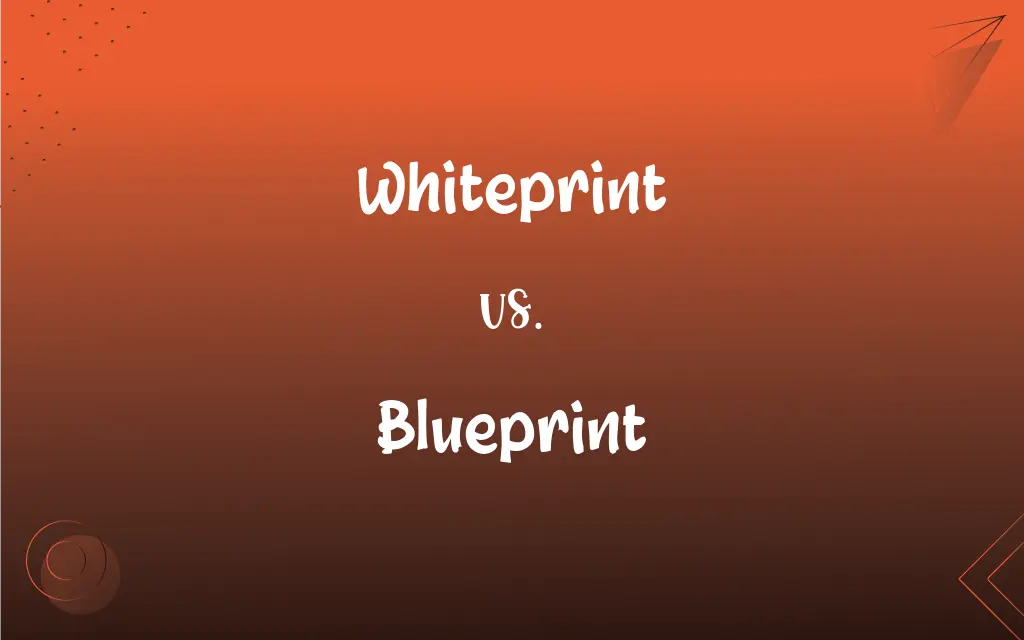Whiteprint vs. Blueprint: What's the Difference?
Edited by Harlon Moss || By Janet White || Updated on October 5, 2023
Whiteprints are documents presenting design details using white lines on a blue background, while blueprints use blue or black lines on a white background.

Key Differences
Whiteprints and blueprints are both schematic representations, the former uses white lines on a blue background, revealing technical designs. Blueprints traditionally employed a blue or black line on a white background to detail architectural or machinery plans.
Whiteprints, as a technical document, are utilized to convey detailed engineering or architectural designs. Blueprints, similarly, serve as a meticulous guideline for builders and engineers to understand the intricacies of a project.
While whiteprints hold value for being able to present clear and concise technical details, blueprints are renowned for their historic significance in the field of architectural design and engineering. Each one, distinguished by its color scheme, delivers intricate details essential in constructing structures or machinery.
In whiteprints, the white lines symbolize the drawing, conveying design specifics against a blue background. Conversely, in blueprints, the blue or black lines represent the drawing, providing precision and clarity on a white background.
In conclusion, whiteprints and blueprints, although different in presentation, share a common purpose of relaying intricate design details, crucial in the realms of construction and manufacturing, serving as invaluable resources for professionals in these fields.
ADVERTISEMENT
Comparison Chart
Color Scheme
White lines on a blue background
Blue or black lines on white background
Usage Era
More modern
Historically significant
Purpose
Conveys technical designs
Serves as a guideline for construction
Clarity
Clearer and concise details
Historic but could lack clarity due to aging
Representation
White lines symbolize the drawing
Blue or black lines represent the drawing
ADVERTISEMENT
Whiteprint and Blueprint Definitions
Whiteprint
Whiteprint is a document displaying white lines on a blue background for design representation.
The engineer handed over the whiteprint detailing the machine’s design.
Blueprint
Blueprint serves as a guideline, detailing the intricacies of construction projects.
The builders relied on the blueprint to construct the building accurately.
Whiteprint
Whiteprint serves as a modern alternative to blueprint, portraying technical designs.
The architect preferred using a whiteprint to illustrate the building plans.
Blueprint
Blueprint, with its historical significance, is renowned in the fields of design and engineering.
The meticulous blueprint laid the foundation for constructing the iconic structure.
Whiteprint
Whiteprint is utilized for presenting clear, concise technical details.
The construction team studied the whiteprint to understand the project’s specifications.
Blueprint
Blueprint is a detailed plan using blue or black lines on a white background, historically used for architectural designs.
The architect created a meticulous blueprint for the new museum.
Whiteprint
Whiteprint, with its distinct color scheme, is essential in construction and manufacturing.
The workers referred to the whiteprint to assemble the parts accurately.
Blueprint
Blueprint is an intricate document presenting design details essential for construction.
The contractor used the blueprint to estimate the materials required for the project.
Whiteprint
Whiteprint is a detailed representation of architectural or engineering designs.
The whiteprint laid out the dimensions and placements of the building’s elements explicitly.
Blueprint
A contact print of a drawing or other image rendered as white lines on a blue background, especially such a print of an architectural plan or technical drawing. Also called cyanotype.
Whiteprint
A photomechanical copy, usually of a line drawing, in which black or colored lines appear on a white background.
Blueprint
A mechanical drawing produced by any of various similar photographic processes, such as one that creates blue or black lines on a white background.
Whiteprint
A reproduction of a document created by means of the diazo chemical process.
Blueprint
A detailed plan of action.
Blueprint
A model or prototype.
Blueprint
To make a blueprint of.
Blueprint
To lay a plan for.
Blueprint
A type of paper-based reproduction process producing white-on-blue images, used primarily for technical and architecture's drawings, now largely replaced by other technologies.
Blueprint
A print produced with this process.
Blueprint
A detailed technical drawing (now often in some electronically storable and transmissible form).
Blueprint
Any detailed plan, whether literal or figurative.
Blueprint
To make a blueprint for.
The architect blueprinted the renovation plan once the client had signed off.
Blueprint
To make a detailed operational plan for.
They blueprinted every aspect of the first phase of the operation.
Blueprint
See under Print.
Blueprint
Something intended as a guide for making something else;
A blueprint for a house
A pattern for a skirt
Blueprint
Photographic print of plans or technical drawings etc.
Blueprint
Make a blueprint of
Blueprint
Blueprint is a representation of technical drawings illustrating design specifics.
The engineer drafted a blueprint to explain the machine’s functioning.
FAQs
Which one is clearer, a whiteprint or a blueprint?
Whiteprints are generally clearer and more concise compared to blueprints.
What is a whiteprint?
A whiteprint is a modern technical document displaying white lines on a blue background to represent design details.
Are whiteprints more modern than blueprints?
Yes, whiteprints are considered more modern compared to the historically significant blueprints.
Do both whiteprints and blueprints serve the same purpose?
Yes, both serve to convey intricate design details, essential in construction and manufacturing.
Can a whiteprint be used as an alternative to a blueprint?
Yes, whiteprints can be used as modern alternatives to blueprints, especially when clarity is a priority.
Can whiteprints and blueprints be used interchangeably in construction?
Yes, they can be used interchangeably, depending on the preference for clarity and detail presentation.
Are blueprints still in use today?
While the term "blueprint" is still widely used, the technology has evolved, and more modern methods like whiteprints or digital prints are common.
How are the lines represented in a whiteprint?
In a whiteprint, the white lines represent the drawing against a blue background.
What is the purpose of a blueprint?
The purpose of a blueprint is to serve as a detailed plan or guideline, traditionally using blue or black lines on a white background, for construction or manufacturing projects.
What do the colors represent in a blueprint?
In a blueprint, blue or black lines represent the drawing on a white background.
Are whiteprints more detailed than blueprints?
Not necessarily, the level of detail depends on the drafter, but whiteprints can offer clearer representation.
How are blueprints significant in history?
Blueprints hold historical significance as they were the primary method for detailing architectural and engineering designs in the past.
Why are whiteprints valuable in the design process?
Whiteprints are valuable as they present clear and concise technical details essential for accurate construction or manufacturing.
Do whiteprints and blueprints have different storage requirements?
While both should be stored carefully to prevent damage, there are no specific differences in storage requirements between the two.
What fields primarily use blueprints?
Blueprints are primarily used in architecture, engineering, and construction.
About Author
Written by
Janet WhiteJanet White has been an esteemed writer and blogger for Difference Wiki. Holding a Master's degree in Science and Medical Journalism from the prestigious Boston University, she has consistently demonstrated her expertise and passion for her field. When she's not immersed in her work, Janet relishes her time exercising, delving into a good book, and cherishing moments with friends and family.
Edited by
Harlon MossHarlon is a seasoned quality moderator and accomplished content writer for Difference Wiki. An alumnus of the prestigious University of California, he earned his degree in Computer Science. Leveraging his academic background, Harlon brings a meticulous and informed perspective to his work, ensuring content accuracy and excellence.































































